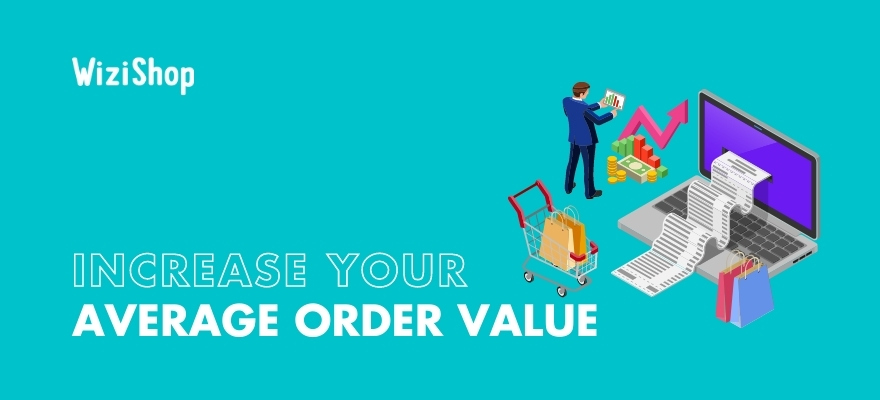There are two primary ways to increase online sales for your ecommerce store. You can attract more customers, or you can entice your customers to place a larger order.
Attracting customers to your ecommerce website is hard work, and it often requires a significant investment of time, energy, and money. While you will always need to see how you can get more customers for your ecommerce business, you can simultaneously work on increasing how much shoppers spend per purchase.
Increasing the average value of each order is effective, sustainable, and optimal for promoting growth.
Definition of average order value: What does AOV mean?
Average order value, or AOV, is the average total spent per order by customers. You can increase your AOV by pulling more value out of each customer who visits your site.
Because driving more traffic to your website requires more resources, getting visitors to spend more is a smart way to bolster your bottom line.
To increase your AOV, you’ll need to sell more items to each customer or sell them more expensive goods. While both of these prospects can seem like uphill battles, there are actually many effective strategies that you can apply to accomplish these goals and boost the attractiveness of your offers.
These tactics can be applied creatively to best suit your unique business model and to appeal to your customers.
Formula for AOV calculation
To calculate the average order value for your site, you can use the following formula:
AOV = total revenue / number of orders
In this calculation, total revenue is the total amount of money generated from sales over a specific period (e.g., a day, week, month, or year), and number of orders is the total number of individual orders placed in that same period.
Let's say you own a store on the web, and in the month of October:
- Total revenue from sales was $50,000.
- Number of orders was 1,000.
Using the formula:
AOV=$50,000 / 1,000 = $50
So, the average order value for October would be $50.
Why is average order value important?
Your store’s AOV is one of the top ecommerce KPIs that you’ll want to keep an eye on. This, along with a variety of real-time ecommerce analytics can help you measure how well your brand is doing and determine how you can improve.
If your goal is to drive more people to your site by expanding your marketing budget, your growth strategy may not be sustainable. This is because your growth is dependent on continuing to invest more resources, financial and otherwise, on marketing efforts. These resources are in limited supply.
However, sustainable growth is tied to optimizing the resources that you’re currently allocating to marketing. You’re squeezing value out of each dollar spent driving those customers to your website.
In some cases, you may also establish loyalty, enhance your brand image, or enjoy other advantages as well.
When you’re successful at increasing your store’s AOV, you can enjoy another important benefit related to operations and logistics. For instance, storing an excessive amount of inventory for a lengthy period of time is unnecessarily expensive.
However, you may need to avail of storage for those items because you’ve purchased supplies in bulk or for other reasons. By increasing your AOV, you can move more inventory and decrease the overhead associated with storing it.
How do you improve average order value in ecommerce?
Whether you aim to sell more goods to each customer or to sell more expensive items, you can work toward your goals in several ways. The actual methods that you use will depend on the types of products you offer in your ecommerce store, your customer base, and other relevant factors.
To help you get started, here are some of the more effective strategies that you can try to produce amazing results.
1. Recommend products
Internet shoppers often search for a specific item rather than window shop. When they find that item, they quickly purchase it and click off of the site.
Encouraging customers to look around your ecommerce site may inspire them to put additional items into their carts that they hadn’t planned on buying.
The easiest way to do this is to simply make a few personalized recommendations. For example, you can include a “Customers Also Purchased” box or a “You May Also Like” box on the pages that the customer is browsing through.

Source: The North Face
2. Use upselling and cross-selling techniques
Both upselling and cross-selling are unique ways to suggest specific types of products to your site visitors and increase your average order value.
Upselling is tied to promoting products that are more expensive than the products that the customer is currently viewing on your website. The intention is to encourage customers to buy a product that may better fit their needs, have more features, or be more appealing in other ways.
Cross-selling, on the other hand, involves offering related products. For example, when a customer purchases a men’s button-down shirt, you could cross-sell by suggesting a tie or a pair of nice pants.
3. Suggest low-cost add-on items
Another deviation of recommending products involves strategically suggesting low-cost add-ons. These are usually offered when the customer is reviewing the shopping cart and preparing to finalize the order.
You can view these suggested add-ons in a similar way to the impulse-buy goods that are located next to cash registers in grocery stores.
The consumer doesn’t usually need those items. Nevertheless, they’re affordable enough and desirable enough to inspire an impulsive addition to the shopping cart at the last minute.
4. Offer discounts when customers spend a set amount
People often look for value when they make buying decisions. The ability to save by adding more items to their cart with a special discount can be difficult to resist.
With this in mind, consider giving a reduction in price when customers spend more than a specific amount. For example, you can supply a 10% concession on orders that exceed $100.
The discount may be most appealing to consumers and most effective at boosting your AOV when the threshold is established just above your current AOV. You can also offer progressively higher discounts when customers meet different thresholds.
5. Start a loyalty program
You can encourage your satisfied customers to shop at your ecommerce site more frequently through membership in a loyalty program. By becoming a program member, they can receive perks like free shipping, special promotions that aren’t available to other shoppers, and other benefits.
You could charge a small monthly fee or a one-time fee to join the loyalty program you create, and revenue would increase as a result. You could also simply use your loyalty program to encourage repeat shopping and to build your email distribution list.
Some of the special offers that are offered through the loyalty program may be combined with other discounts that have been discussed.
6. Create product bundles
You can incentivize the purchasing of an extra product or two by offering free or discounted merchandise in a bundle package. For example, customers can buy three of one item to get the fourth item at no extra charge.
They could also receive a small, relatively affordable item for free if they buy two or more of another type of item. This method can help you to move inventory faster and increase your AOV simultaneously.
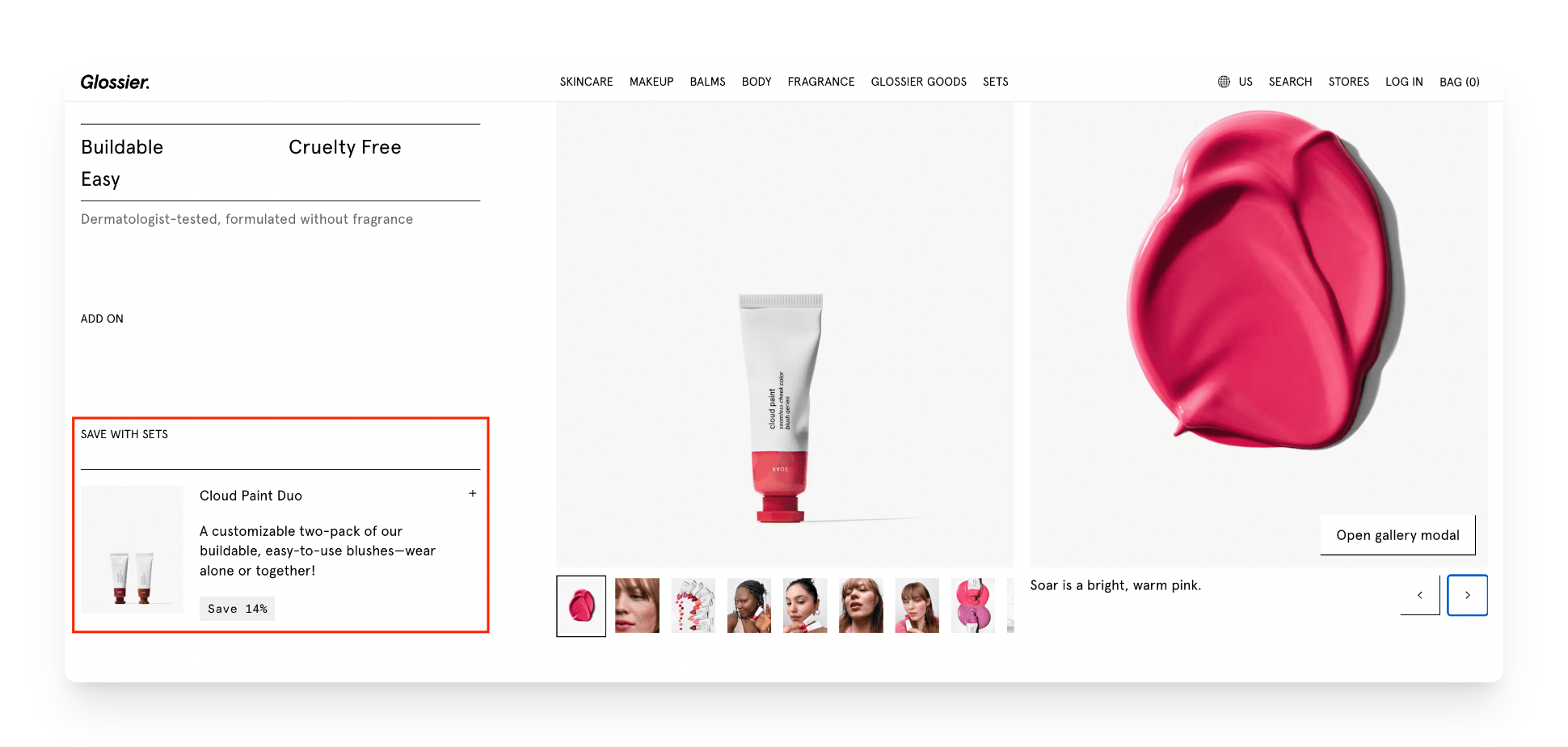
Source: Glossier
7. Set a minimum spending threshold for free shipping
Internet shoppers love free shipping, but providing this on small orders is not a very cost-effective tactic unless you have a sizable profit margin. Shoppers understand the value that complimentary shipping offers them, so they may jump at the chance to save money with a special offer.
One way to execute this plan is by setting a minimum spending threshold, such as $50 or $100, to qualify for complimentary shipping. This encourages customers to spend more, and it makes it more affordable for you to offer this shipping perk.
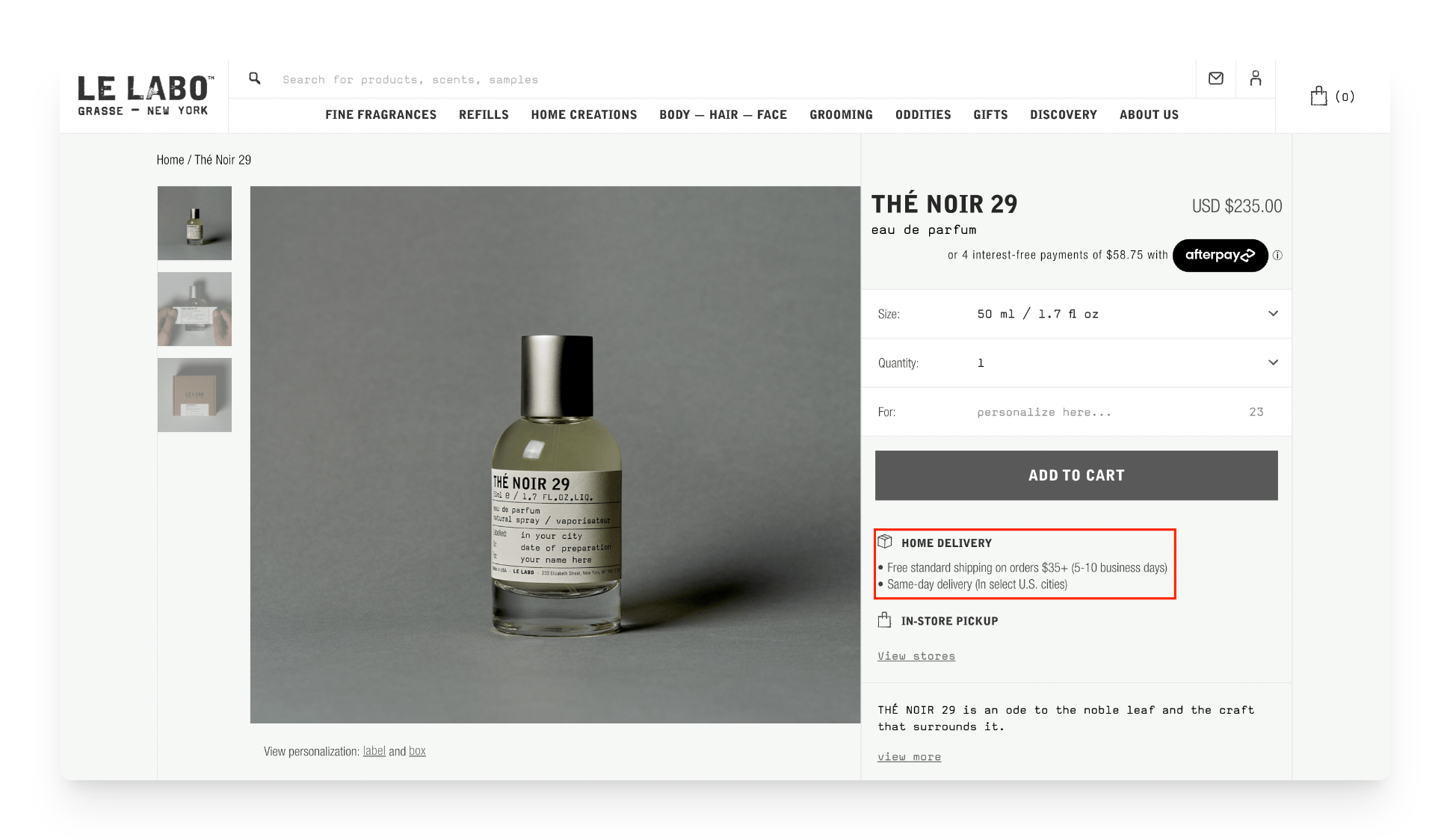
Source: Le Labo
8. Make use of price anchoring
With this psychological marketing strategy, you give customers a price point to refer to when they’re trying to decide what to buy. It encourages them to compare different products and can have a major influence on their purchasing decisions.
For instance, you could display a discounted product adjacent to comparable items that are being sold at the regular, or anchor, price. Customers see that they’re getting a great deal with the discounted product, which can push them in the direction of clicking that “Add to cart” button!
To further emphasize the savings, you can even show exactly how much the customer will save by buying the product that’s on sale. This may even make the customer want to purchase multiple items, further increasing your AOV.
9. Offer gift cards
Shoppers often view a gift card as free money, so gift cards are a great incentive for customers to spend more.
For example, you could give a $5 gift card on a purchase of $50 or more. A customer that was only going to spend $30 or $40 may put another item or two into the shopping cart in order to receive the gift card.
This approach offers extra benefits. One of which is that it encourages the customer to come back to the online store before he or she may have otherwise done so to make another purchase with the gift card. It also encourages faster movement of inventory.
10. Provide first-purchase discounts to new customers
Regardless of the age of your ecommerce store, a first-purchase discount can drive sales. When the discount is offered as savings on a purchase above a specific dollar threshold, you can increase revenue.
Furthermore, you have the opportunity to turn new customers into repeat customers when you offer follow-up promotions.
When your ecommerce store is new, a first-purchase discount may be particularly beneficial at driving pricier orders right away. As a result, this method can bolster revenue.
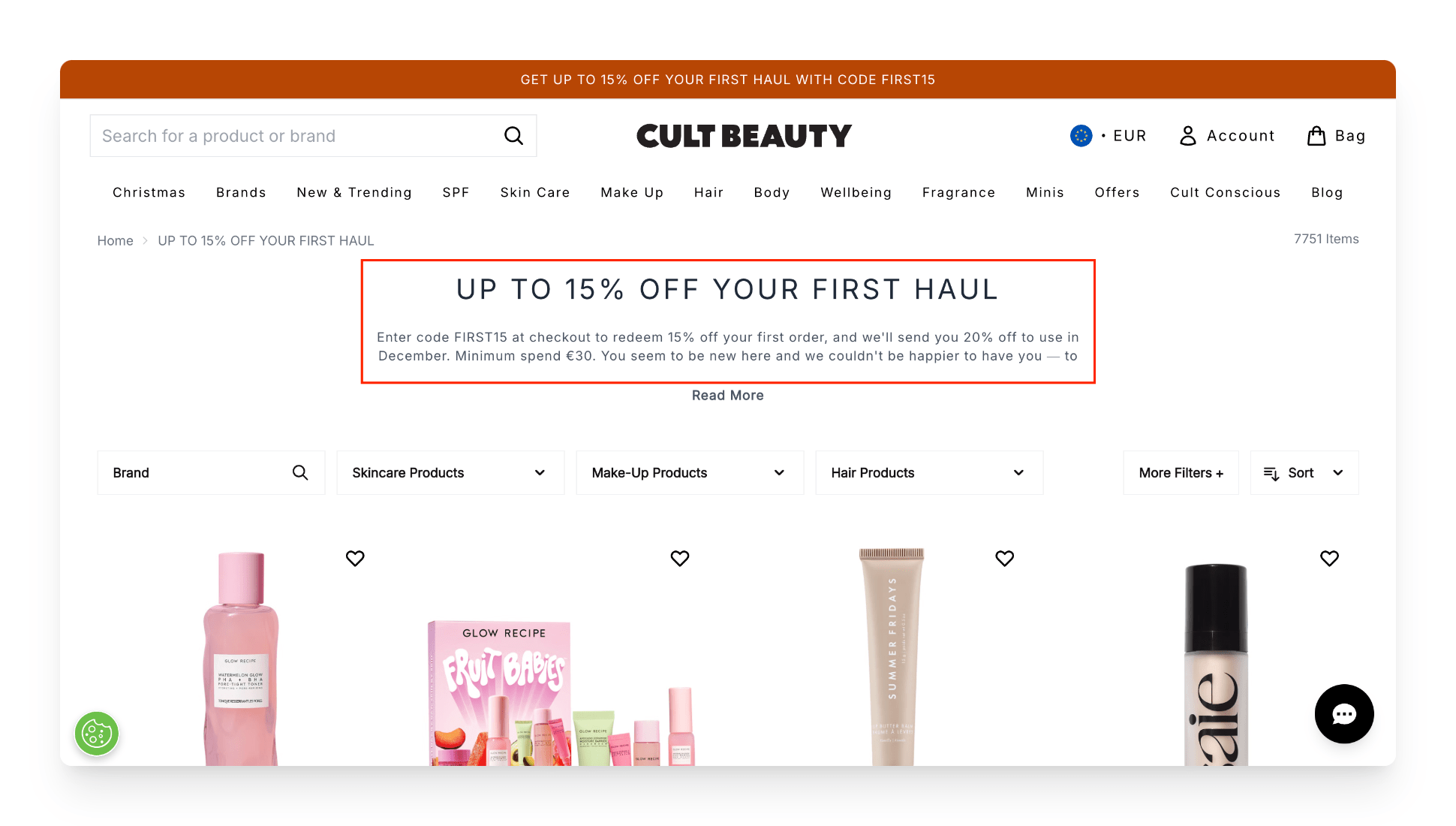
Source: Cult Beauty
11. Feature time-sensitive deals
If your goal is to increase AOV and to motivate customers to buy something immediately, offering a time-sensitive discount is a smart option. You can incorporate many different types of discounts and promotions with this strategy.
One idea is to give 20% off an order of $50 or more for orders placed within the next 48 hours. You can also offer a similar deadline for free shipping over a specific dollar amount, for a bundled deal, or for other promotions.
12. Incorporate a game or contest
Hosting a game or contest is an excellent way to generate interest in your store through social media marketing and other forms of digital marketing. There are various ways to create a boost in AOV through your game or contest.
For example, you can offer free entry into a contest or a giveaway for customers who buy two or more of a specific item. You could also offer this benefit to people who spend more than a minimum amount.
13. Offer payment plans and financing options
If your store sells expensive items, establishing financing or payment plan options could yield exciting results. While many consumers may be interested in your products, they may not be able to afford to pay the full price up-front.
When you provide a flexible payment option, the customer may be thrilled to take advantage of that offer and make the purchase today.
14. Make your return policy flexible
Having a flexible return policy may seem counterintuitive to boosting your average order value. However, it actually plays a significant role in inspiring consumer confidence.
When consumers are uncertain about how easily they can return a product that doesn’t live up to expectations, they may be hesitant to purchase. On the other hand, a flexible return policy can help consumers feel more comfortable making a larger purchase or buying more items.
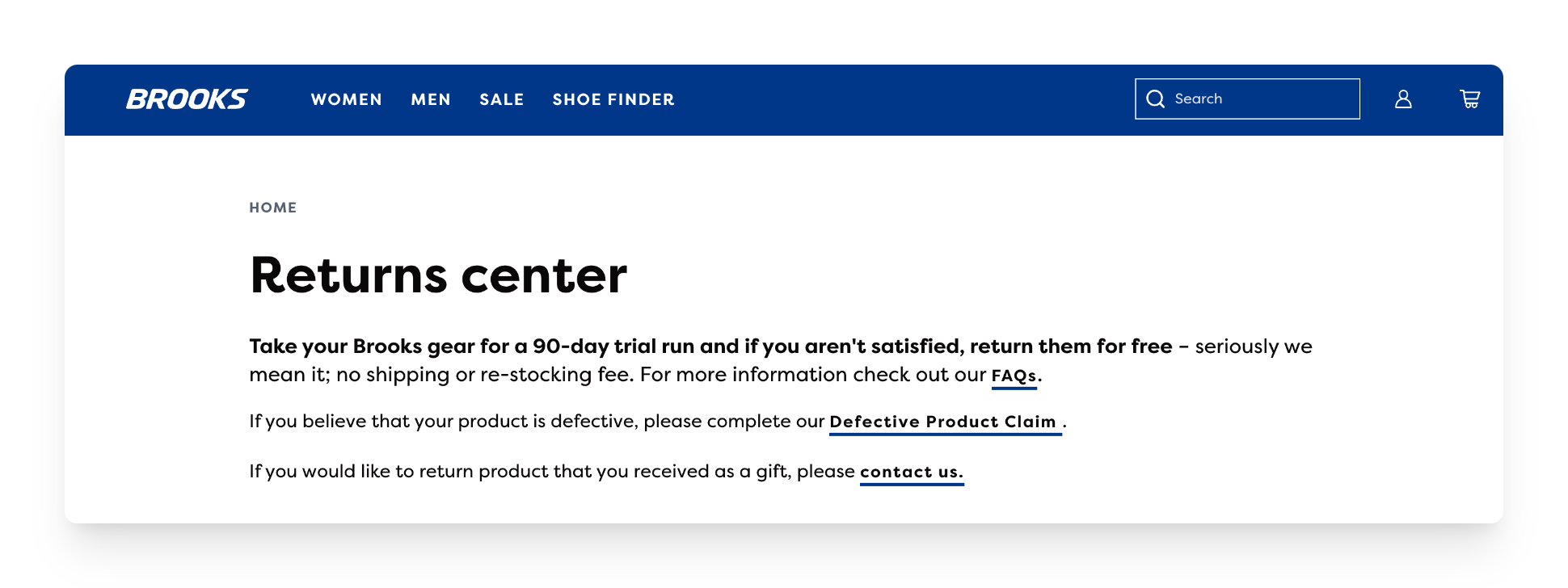
Source: Brooks
15. Target customers according to how they browse
If your store appeals to a diverse customer base, you may discover that some of these strategies are only moderately effective overall. However, with thorough analysis, you may learn that contests, free shipping, or other strategies are very effective with select customers.
Analytics can be used to strategically target customers with personalized product discounts, upsell offers, and other strategies based on their behavior on your website and past purchases.
16. Utilize chatbots for customer support
While chatbots may seem impersonal, they provide customers with a sense of confidence that support is immediately available from your store. Chatbots can be used strategically to increase AOV by offering suggestions, helping create opportunities to upsell and cross-sell.
They can also answer questions about products to improve conversion rates. An important side benefit of chatbots is that they can keep your overhead lower by reducing the need for a large customer service department.
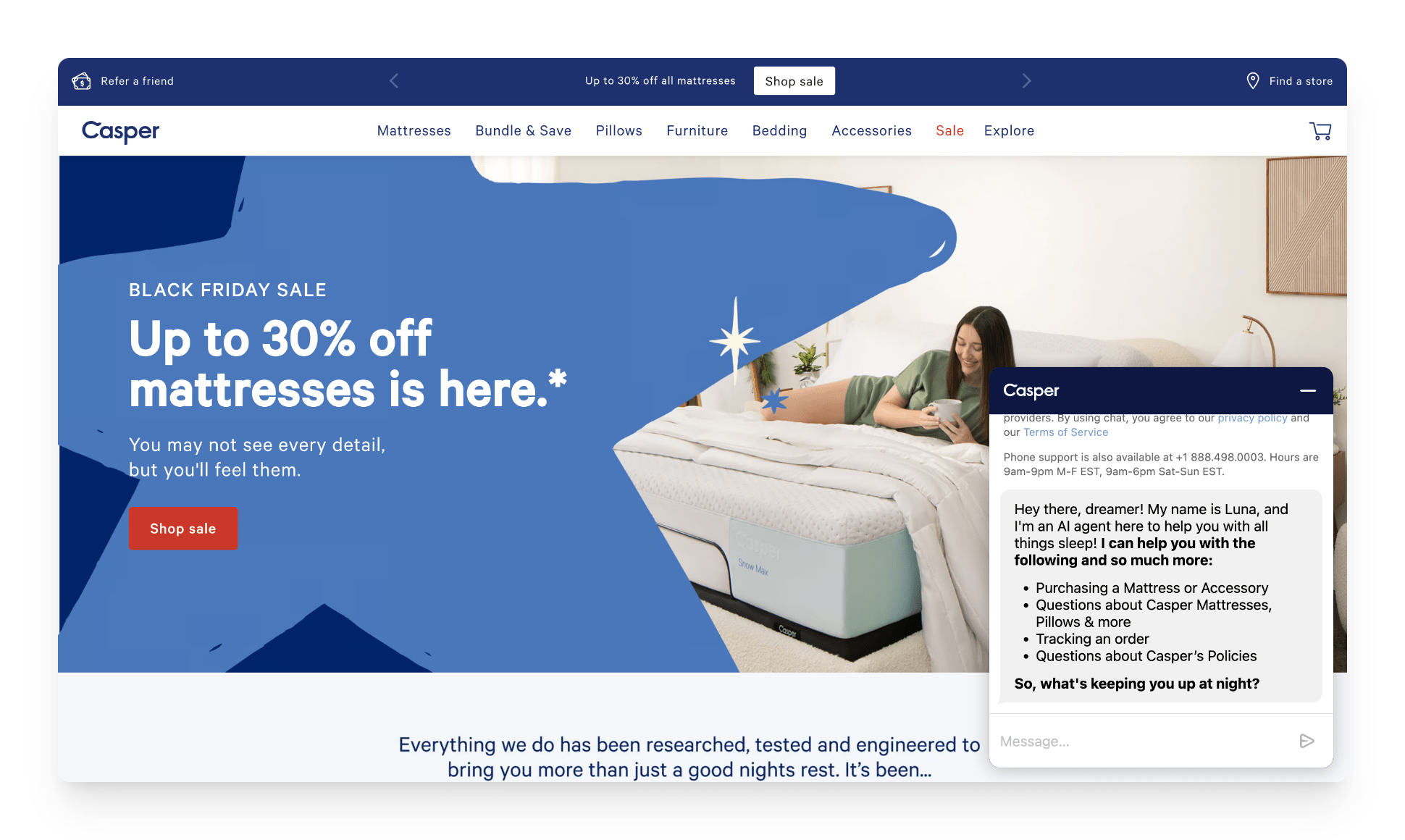
Source: Casper
17. Engage in split testing to adapt your marketing strategy
Some of these approaches may be more effective with your customers than others. How can you know which strategies will produce the best results?
Conduct a split test to measure the results of two different strategies. Continue testing different strategies, messages, and products so that you can determine which ones your customers respond well to.
What influences average order value?
There are a number of factors that can influence the average order value for online businesses. Here are a few to consider when determining how to boost the AOV for your own brand:
Industry
Different industries naturally have varying AOVs due to the types of products and services offered. For example, a shop selling luxury goods or electronics is typically going to have a higher AOV than one involving fast fashion or grocery items.
The industry also impacts purchasing frequency and customer behavior. For instance, in the travel or automotive industries, customers are likely to spend a significant amount per transaction but may not make purchases frequently. In contrast, in fast-moving consumer goods (FMCG), customers may make frequent purchases with lower AOVs.
Product pricing
The price range of products offered by a brand directly influences average order value. Higher-priced items, like furniture or electronics, naturally drive up AOV, while companies selling lower-cost items will have a lower AOV. Offering premium versions of products, add-ons, or accessories can increase the overall order value per purchase.
Customer demographics
Demographics, such as age, income, and geographic location, impact spending behavior and therefore AOV. Higher-income customers, for instance, may be more inclined to purchase higher-value products or more items per order. Younger demographics might favor lower-priced items and smaller purchases, while older demographics with more disposable income may have higher average orders.
Seasonality
Different seasons, holidays, or events (like Black Friday, holiday seasons, or back-to-school) can affect AOV. During these times, consumers tend to buy more items or higher-value items, increasing average order value. Seasonal trends, especially for retail businesses, often lead to higher AOV due to promotions and discounts on bundled items.
Economic conditions
Economic factors, such as inflation or economic downturns, affect consumer purchasing power and behavior. In tougher economic times, consumers might make fewer purchases or buy lower-cost items, reducing AOV. Conversely, in times of economic stability or growth, consumers may feel more comfortable making larger or more frequent purchases, potentially increasing AOV.
Shopping experience and website design
A user-friendly website that encourages exploration and makes product recommendations best suited to the visitor's needs can positively impact average order value. For instance, effective product recommendations or "customers also bought" features encourage customers to add more to their cart.
A streamlined checkout process that makes it easy for customers to add items last-minute can boost AOV, especially if they see complementary products right before completing a purchase.
Product range and upselling opportunities
Featuring a range of complementary products enables effective cross-selling and upselling, which can augment AOV. For example, an electronics store may offer cases, chargers, and screen protectors that customers purchase alongside a smartphone.
If the product range is limited, opportunities to upsell or cross-sell are reduced, and average order value may be lower.
Conclusion
Developing an effective marketing plan and considering various ecommerce marketing costs are vital to the success of any ecommerce business. However, marketing is not the only driver of sales that you should focus on.
Optimizing the value of each visitor to your website is essential if you want to grow your business strategically while conserving limited resources.
Free shipping, personalized product recommendations to best suit customer needs... Try the various strategies described above to increase your average order value and be sure to check out our other ecommerce tips to reap exciting returns for your ecommerce business!


